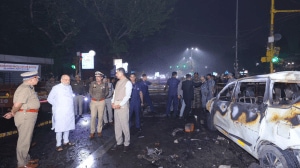Ethnic ties, family bonds: Why Mizoram is concerned about Manipur violence
Late Wednesday night, as the first reports of the “solidarity march” called by tribal organisations turning violent emerged, Mizoram Chief Minister Zoramthanga tweeted how he was “deeply pained” by the happenings.
 People from Manipur raise slogans during their protest against the ongoing violence in Manipur, at Jantar Mantar in New Delhi, Saturday, May 6, 2023. (Express Photo by Amit Mehra)
People from Manipur raise slogans during their protest against the ongoing violence in Manipur, at Jantar Mantar in New Delhi, Saturday, May 6, 2023. (Express Photo by Amit Mehra) Last week, as the initial reports of the unrest in Manipur emerged, its neighbour Mizoram was the first to express “deep concern” on the matter — from Chief Minister Zoramthanga to Rajya Sabha MP Vanlalvena, the Mizoram government has been sending missives to the Centre asking for urgent intervention.
The Manipur unrest
The clashes in Manipur — primarily involving the numerically dominant Meitei community and the minority Kuki tribe — have left over 60 dead, hundreds injured and thousands displaced in the last few days.
 A “tribal solidarity march” on May 3 — to protest against the inclusion of the Meiteis in the Scheduled Tribe (ST) category — was just the immediate trigger. For months now, the Biren Singh-led BJP government’s actions — from the crackdown on poppy plantations and eviction drives, to frequent allegations that the Kukis of Churachandpur were sheltering “foreigners” from Myanmar — have led to simmering tensions in the state’s southern hill districts, which border Myanmar.
A “tribal solidarity march” on May 3 — to protest against the inclusion of the Meiteis in the Scheduled Tribe (ST) category — was just the immediate trigger. For months now, the Biren Singh-led BJP government’s actions — from the crackdown on poppy plantations and eviction drives, to frequent allegations that the Kukis of Churachandpur were sheltering “foreigners” from Myanmar — have led to simmering tensions in the state’s southern hill districts, which border Myanmar.
The 2021 coup across the border, where the Myanmarese Army took control of the country, was an inflection point of sorts: it led to thousands fleeing to Manipur and Mizoram, seeking shelter. While Mizoram welcomed the refugees, the Manipur government said it would go by the Centre’s directives to seal borders and turn away shelter-seekers.
Mizoram’s stand
Late Wednesday night, as the first reports of the “solidarity march” called by tribal organisations turning violent emerged, Mizoram Chief Minister Zoramthanga tweeted how he was “deeply pained” by the happenings.
🕊️@narendramodi @AmitShah @NBirenSingh @PIBImphal @TheSangaiExpres @dipr_mizoram @DiprManipur pic.twitter.com/bMoej1hBHf
— Zoramthanga (@ZoramthangaCM) May 3, 2023
The following morning, Zoramthanga wrote a letter to Manipur Chief Minister N Biren Singh requesting him to reach out to all parties and end the “senseless violence”. In his video statement following the violence, Biren mentioned Zoramthanga’s concerns, and assured his Mizoram counterpart that things would be “settled and normalised”.
Had a lengthy and fruitful conversation with Hon’ble Union Home Minister Shri @AmitShah Ji and Hon’ble CM Manipur Shri @NBirenSingh Ji.
I sincerely hope that #peace will be restored in #Manipur @narendramodi @dipr_mizoram @DiprManipur @TheSangaiExpres @BJP4Manipur @CMOMizoram pic.twitter.com/3JQWZ186we
— Zoramthanga (@ZoramthangaCM) May 4, 2023
Shortly after, the Home Department of Mizoram issued a statement expressing solidarity with the “Zohnahthlak” people: Kuki-Chin-Mizo ethnic group. The government also released an official notification asking deputy commissioners of all districts in the state to be on high alert and make appropriate arrangements to shelter those who were seeking refuge in Mizoram.
On May 7, Lok Sabha MP C Lalrosanga dialled the chief of the Indian Army General Manoj Pande to discuss the issue. Two days later, Rajya Sabha MP from Mizoram K Vanlalvena wrote to Prime Minister Narendra Modi requesting a “joint parliamentary team” — which should include MPs from Christian minorities — to probe into the violence. On Thursday, Vanlalvena tweeted: “Different tribes of Mizo ethnic community in Manipur may think that they don’t have any Member of Parliament of their own. I want to let them know that I am their MP.”
Besides, through the last week, the state’s influential civil society organisations, such as the Young Mizo Association (YMA), have been issuing statements urging the Manipur government to ensure safety and security for the “ethnic Zo tribes” affected in the clashes. The YMA has released aid of Rs 5 lakh for the Chin-Kuki-Mizo people affected by the violence in Manipur.
The ethnic bond
At the heart of Mizoram’s strong political reaction is the deep ethnic bond the Mizos and Kukis share. The Chin-Kuki-Mizos are a conglomerate ethnic group collectively known as the ‘Zo’ people.
“Historically, culturally, socially, linguistically, they are all related,” said Professor Jangkhongam Doungel who teaches in the department of political science in Mizoram University.
According to him, these “ethnic tribes commonly traced their historical origin to a mythological cave known by different names by different tribes”. He explained, “They are known as Chin when they settle in Burmese plains and Chin became their official name in Burma. Those who moved down to Lushai Hills (Mizoram) and Chittagong Hill Tracts (Bangladesh) from Chin Hills were known as Kuki and Kuki became the official name in India.” He added, “The term ‘Mizo’ began to be used officially in Lushai Hills (present Mizoram) since 1946. After that, Mizo began to be used popularly in Mizoram.”
These ethnic bonds continue to endure across state and international boundaries, said Doungel, adding: “If your own brother and sisters are killed, would you not react? That is the reaction of Mizoram.”
Following the unrest, Mizoram is currently hosting nearly 3,000 people displaced during the violence in Manipur. A Mizo politician, speaking on the condition of anonymity, said “most of them were their relatives”. He blamed the BJP government in Manipur for allowing the situation to explode. “If they would have handled the refugee situation better, this would not have happened,” he alleged.






































